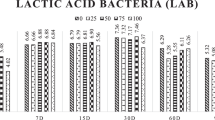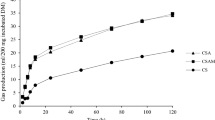Abstract
The objective of this study was to investigate the effect of four levels of molasses on chemical composition, in vitro digestibility, methane production and fatty acid profile of canola silages. A canola (Brassica napus var. Monty) crop was established in a small-scale agricultural farm and harvested 148 days after sowing. Four levels of molasses were tested with respect to the fresh weight (1.5 kg); these were 1% (CS-1), 2% (CS-2), 3% (CS-3) and 4% (CS-4) molasses, and 0% molasses (CS-0) was included as a control. A total of 45 microsilages were prepared using PVC pipes (4 in. of diameter × 20 cm of length), and the forage was compressed using a manual press. The effects of control and treatments were tested using the general linear model Y = μ + Ti + Eij. The linolenic acid (C18:3n3), palmitic acid (C16:0) and linoleic acid methyl ester (C18:2n6c) accounted for 30%, 21% and 10.5% of total fatty acids, respectively; the fermentation parameters and in vitro methane production were not affected (P > 0.05) by treatments; in vitro digestibility decreased significantly (P < 0.05) as the level of molasses increased. It was concluded that CS-4 improved the DM content by 9% and showed high content of linolenic acid methyl ester. The gross energy of canola silages could favour the oleic acid methyl ester.
Similar content being viewed by others
References
Alexander, J. W., 1998. Immunonutrition: The role of-3 fatty acids. Nutrition 14:627–633.
AOAC, 2012. Official Methods of Analysis. 19th ed. AOAC: International, USA. pp: 34–36.
Balakhial, A., Naserian, A. A., Heravi, M. A., Eftekhar, S. F. and Vali, Z. R., 2008. “Changes in Chemical Composition and In vitro DM Digestibility of Urea and Molasses Treated Whole Crop Canola Silage”, Journal of Animal and Veterinary Advances, 7(9): 1042–1044, ISSN: 1680–5593, 1993-601X.
Barry, T. N., 2013. The feeding value of forage brassica plants for grazing ruminant livestock, Animal Feed Science and Technology, 181, 15–25
Bauman, D. E., Baumgard, L. H., Corl, B. A., Griinari, J. M., 1999. Biosynthesis of conjugated linoleic acid in ruminants, Proceedings of the American Society of Animal Science, pp:1–15.
Bauman, D. E., Corl, B. A., Baumgard, L. H., Griinari, J. M., 2001. Conjugated linoleic acid (CLA) and the dairy cow. In: Garnsworthy, P.C., Wiseman, J. (Eds.), Recent Advances in Animal Nutrition 2001. Nottingham. University Press, Nottingham, UK, pp. 221–250.
Baytok, E., Aksu, T., Karslı, M. A., Muruz, H., 2005. The effects of formic acid, molasses and inoculant as silage additives on corn silage composition and ruminal fermentation characteristics in sheep, Turkish Journal of Veterinary And Animal Sciences, 29: 469–474
Bolsen, K. K., G. Ashbell and Weinberg, Z., 1996. Silage fermentation and silage additives, Asian-Australasian Journal Animal Sciences, 9: 483–491.
Broderick, G. A., Kang, J. H., 1980. Automated simultaneous determinations of ammonia and total amino acids in ruminal fluid and in vitro media, Journal of Dairy Science, 63, 64–75.
Bye, R., Linares E., 2000. Los quelites, plantas comestibles de México: una reflexión sobre el intercambio cultural. CONABIO. Biodiversitas 31,11–14.
Cruz, C. J. J., Núñez, H. G., Faz, C. R., Reta, S. D. G., Serrato, M. H. A., 2012. Potencial forrajero y eficiencia de uso del agua de canola (Brassica napus L.) en comparación con cultivos tradicionales en el ciclo de invierno, Agrofaz 12:125–130.
Elgersma, A., Tamminga, S., Ellen, G., 2006. Modifying milk composition through forage, Animal Feed Science and Technolgy, 131: 207–225.
Fales, S. L., Gustine, D. L., Bosworth, S. C., Hoover, R. J. 1987., Concentrations of glucosinolates and S-methylcysteine sulfoxide in ensiled rape (Brassica napus L), Journal of Dairy Science, 70, 2402–2405
Hall, M. H., and Jung, J., 2008. Use of brassica crops to extend the grazing season. Pennsylvania State University Agricultural Cooperative Extension. Agronomy Fact 33. Available at http://pubs.cas.psu.edu/FreePubs/pdfs/uc100.pdf (access august, 2017).
Harfoot, C. G. and Hazlewood, G. P., 1997. Lipid metabolism in the rumen. In: The Rumen Microbial Ecosystem. PN Hobson (Ed). London, UK, Elsevier. 382–426.
Jessop, N. S. and Herrero, M., 1996. Influence of soluble components on parameter estimation using the in vitro gas production technique, Animal Science, 62: 626–627.
Kincaid, R. L., Johnson, K. A., Michal, J. J., Huisman, A. C., Hulbert, S. H., Pan, W. L., 2012. Case study: production of silage containing biennial canola and peas for use as forage in a dairy ration, The Professional Animal Scientist, 28, 120–124.
NRC. National Research Council 2000. The nutrient requirements of Dairy cattle. 6th ed. Washington, DC, USA: National Academy Press.
Palmquist, D. L., and Jenkins, T. C., 2003. Challenges with fast and fatty acid methods. Journal Animal Science, 81: 3250–3254.
Pell, A. N., Schofield, P., 1993. Computerized monitoring of gas production to measure forage digestion in vitro, Journal of Dairy Science, 76:1063–1073
Reta, S. D. G., Serrato, C. J. S., Quiroga, G. H. M., Gaytán, M. A., Figueroa, V. U., 2015. Forage yield and chemical composition of canola (Brassica napus L.) as affected by sowing methods, Grass Forage Science, 71 (2), 281–290.
Sinclair, L. A., Edwards, R., Errington, K. A., Holdcroft, A. M., Wright, M. 2015. Replacement of grass and maize silage with lucerne silage: effects on performance, milk fatty acids profile and digestibility in Holstein-Friesian dairy cows. Animal, 9 (12), 1970–1978.
Suárez, R., Mejía, J., González, M., García, D. E., Perdomo, D. A., 2011. Evaluación de ensilajes mixtos de Saccharum officinarum y Gliricidia sepium con la utilización de aditivos, Pastos y Forrajes, 34:1.
Sun, X. Q. and Gibbs, 2012. Diurnal variation in fatty acid profiles in rumen digesta from dairy cows grazing high-quality pasture, Animal Feed Science and Technology, 177: 152–160.
Theodorou, M. K., Williams, B. A., Dhanoa, M. S., McAllan, A. B., France, J. A., 1994. Simple gas production method using a pressure transducer to determine the fermentation kinetics of ruminants feeds. Animal Feed Science and Technology, 48:185–197.
Van Soest P.J. 1994. Nutritional ecology of the ruminant. 2nd ed. Ithaca, NY; Comstock, Cornell University Press.
Wiking, L., Theil, P. K., Nielsen J. H., Sørensen, M. T. 2010. Effect of grazing fresh legumes or feeding silage on fatty acids and enzymes involved in the synthesis of milk fat in dairy cows. Journal of Dairy Research, 77, 337–342.
Williams, S. R. O., Moate, P. J., Deighton, M. H., Hannah, M. C., Wales, W. J., Jacobs, J. L., 2016. Milk production and composition, methane emissions from dairy cows fed Lucerne hay with forage brassica or chicory, Animal Production Science, 56, 304–311.
Funding
The authors express their gratitude to the Universidad Autónoma del Estado de México for the financial support within the project (4372/2017/CI) “Producción in vitro de intermediarios de la biohidrogenación de ácidos grasos insaturados y metano del forraje de canola para la alimentación de ruminates”. This work was carried out within the project “Estrategias de alimentación basadas en forrajes de calidad y su efecto en la composición de ácidos grasos en leche de rumiantes” (UAM-PTC-490, DSA/103.5/14/11131) and within the project “Desarrollo de modelos de optimización para mitigar los gases de efecto invernadero provenientes de las explotaciones ganaderas”, project number 247825, funded by the Consejo Nacional de Ciencia y Tecnología (CONACyT), México. Authors express their gratitude also for the grant provided to Daniel Limón-Hernández by CONACyT.
Author information
Authors and Affiliations
Corresponding author
Ethics declarations
Conflict of interest
The authors declare that they have no competing interests.
Additional information
Publisher’s note
Springer Nature remains neutral with regard to jurisdictional claims in published maps and institutional affiliations.
Rights and permissions
About this article
Cite this article
Limón-Hernández, D., Rayas-Amor, A.A., García-Martínez, A. et al. Chemical composition, in vitro gas production, methane production and fatty acid profile of canola silage (Brassica napus) with four levels of molasses. Trop Anim Health Prod 51, 1579–1584 (2019). https://doi.org/10.1007/s11250-019-01849-7
Received:
Accepted:
Published:
Issue Date:
DOI: https://doi.org/10.1007/s11250-019-01849-7




